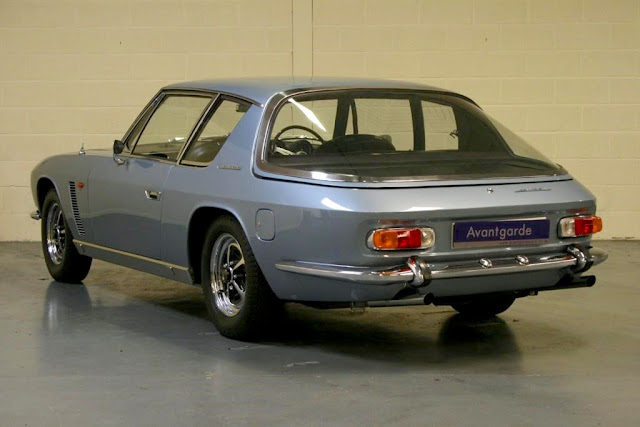The Jensen Interceptor is a great example of what happens when you get the Italians, Brits and Americans in a room in the late-60s to collaborate on a multi-national muscle car. Design was tasked to the Italians by way of Carrozzeria Touring, construction took place at the Jensen factory in Birmingham and the engine/transmission were supplied by the Americans.
Originally introduced in 1966, the Interceptor was originally produced in three distinct generations, Mk I, II and III. It was a hand-built sports GT car with a price tag approximately 60% higher than that of the Jaguar E-Type. The relatively high cost and limitations of the handmade coach work meant that the Jensen Interceptor was never a huge seller.
Perhaps the most famous feature of the Interceptor is the large V8 that sits under the hood, the smallest variant was a 383 cubic inch (6.3 L) Chrysler V8, and the larger was the 440 cubic inch (7.2 L) Chrysler unit.
The third generation Interceptor, the Mark III, introduced in 1971, revised the front grille, headlamp finishers and bumper treatment again. It had GKN alloy wheels and air conditioning as standard, and revised seats. It was divided into G-, H-, and J-series depending on the production year. The “J” version of Interceptor III was the most luxurious Jensen built. The 6.3 L 383ci engine was superseded by the 7.2 L 440ci in 1971. Besides the Sports Saloon models, it was also the only generation to be offered as a convertible and a coupé.
The IIIs made from 1974 to 1976 were classified by the factory as the Series 4 and Series 5. The first “Series 4” car was built on a production 1973 J-series chassis and displayed at the 1973 Earls Court Show. The Interceptor III Series 4 was launched in 1973 just as war broke out in the Middle East and the first of the oil shocks of the 1970s began. For Jensens, reliant in large part on sales of the expensive, gas-guzzling Interceptors, the changed conditions wrought havoc with the financial bottom line.
Over the course of its 10 year production run just over 6,400 were produced, almost all of which were the classic hatchback, with 509 convertibles and just about 60 coupés rounding out the numbers. By 1975 the company had fallen on hard times due to the then world-wide recession. Production of the Interceptor ended in 1976.
A group of investors stepped in and re-launched production of the Interceptor, which was briefly re-introduced in the late 1980s as the Series 4 (S4). The car came back as a low-volume hand built and bespoke affair. (silodrome.com & wikipedia)
The third generation Interceptor, the Mark III, introduced in 1971, revised the front grille, headlamp finishers and bumper treatment again. It had GKN alloy wheels and air conditioning as standard, and revised seats. It was divided into G-, H-, and J-series depending on the production year. The “J” version of Interceptor III was the most luxurious Jensen built. The 6.3 L 383ci engine was superseded by the 7.2 L 440ci in 1971. Besides the Sports Saloon models, it was also the only generation to be offered as a convertible and a coupé.
The IIIs made from 1974 to 1976 were classified by the factory as the Series 4 and Series 5. The first “Series 4” car was built on a production 1973 J-series chassis and displayed at the 1973 Earls Court Show. The Interceptor III Series 4 was launched in 1973 just as war broke out in the Middle East and the first of the oil shocks of the 1970s began. For Jensens, reliant in large part on sales of the expensive, gas-guzzling Interceptors, the changed conditions wrought havoc with the financial bottom line.
Over the course of its 10 year production run just over 6,400 were produced, almost all of which were the classic hatchback, with 509 convertibles and just about 60 coupés rounding out the numbers. By 1975 the company had fallen on hard times due to the then world-wide recession. Production of the Interceptor ended in 1976.
A group of investors stepped in and re-launched production of the Interceptor, which was briefly re-introduced in the late 1980s as the Series 4 (S4). The car came back as a low-volume hand built and bespoke affair. (silodrome.com & wikipedia)
(Photos from bonhams.com & car-from-uk.com)
Jensen Interceptor Mk I Sports Saloon (1966-69)
Starting with the 6276 cc (383 c.i.) V8 that produced 325 hp, with optional manual or TorqueFliteautomatic transmissions. Zero to sixty sprint took a mere 7.1 seconds - an excellent time for 1966 - with a 135 mph top speed for the 383 Only 22 built.
Jensen Interceptor Mk II Sports Saloon (1969-71)
For 1971, two 440 c.i. engines were offered. One had a 4-barrel carburetor and produced 305 hp SAE net. The other, which had three 2-barrel carburetors and produced 330 hp SAE net, was only available in 1971. Only 232 cars were built with the 440 "Six Pack", and had the distinction of being the most powerful car ever to have been made by Jensen. (wikipedia)























































































